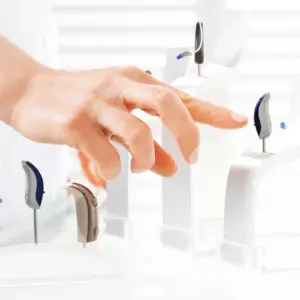Hearing Aid Repairs: What to Expect
Navigating the world of hearing aid repairs doesn’t have to be daunting. Whether you’re troubleshooting at home or deciding it’s time for professional assistance, understanding what steps to take can significantly enhance your hearing aid’s performance and longevity. In this guide, we’ll walk you through both DIY fixes and when to seek help from specialists like Stanford Hearing.
DIY Troubleshooting: Simple Fixes to Common Issues
Before rushing to a specialist, you can manage several common hearing aid repairs at home. These steps not only save time but also ensure your device remains in top shape without risking your warranty.
- Clean Your Device Regularly: A quick wipe with a soft, dry cloth removes obstructions and maintains clarity. Refrain from using water or aggressive cleaning agents.
- Battery Basics: Dead batteries are often culprits for malfunction. Replace them with new ones, ensuring correct insertion and compartment closure.
- Volume Checks: Low or muted volume can usually be corrected by adjusting the volume settings or ensuring the device isn’t locked on a low setting.
- Manage Moisture: Exposure to moisture can impair functionality. Open the battery compartment to air dry your device, avoiding direct heat sources for drying.
Discover more about hearing aid maintenance.
Advanced Home Hearing Aid Repairs:
- Wax Removal: Utilize manufacturer-provided tools for safe wax removal, avoiding damage to sensitive parts.
- Debris Cleaning: A soft brush or toothpick can gently clear microphone and receiver openings, enhancing sound quality.
Recognizing and Addressing Specific Problems:
- No Volume or Low Volume: Check power settings, battery placement, and cleanliness.
- Distortion or Unclear Sound: Inspect and possibly replace batteries. Check for and clean any dirty battery contacts.
Remember, while these steps benefit immediate and minor issues, recognizing when to seek professional assistance to fix hearing aids safeguards your device’s integrity and overall hearing experience.
When DIY Just Isn’t Enough: The Significance of Professional Repairs
Despite our best efforts at home maintenance and troubleshooting, some hearing aid repairs extend beyond the scope of simple DIY solutions. In such cases, the expertise of professional hearing aid repair services becomes valuable and essential. Understanding when to escalate from home fixes to professional repair can prevent further damaging your device and ensure its optimal performance. Here are detailed insights on when and why to seek professional help:
Distorted or Crackling Sounds:
When your hearing aid emits distorted, crackling, or static sounds, it may indicate internal electrical issues, such as problems with the microphone or speaker. These complex issues require professionals’ diagnostic tools and expertise to identify and rectify the underlying cause accurately.
Uneven Volume or Feedback:
If adjusting the volume doesn’t resolve issues of uneven sound levels or persistent feedback, the problem might be with the hearing aid’s circuitry or misalignment within the device. Professional technicians can recalibrate and adjust your hearing aid to eliminate these issues, ensuring clarity and comfort.
Understand more about hearing aid feedback.
Performance Issues:
A battery that depletes faster than expected can signal internal faults or misconfigurations that aren’t apparent to the average user. Professionals can diagnose whether the issue stems from a battery fault, power management within the device, or other internal defects.
Sudden Loss of Power:
Frequent, unexplained shutdowns or loss of power in your hearing aid can be frustrating. This issue often points to deeper electronic or connectivity problems that require a professional’s touch to diagnose and solve effectively.
Visible Damage:
Visible cracks, breakage, or any form of physical damage to the hearing aid not only affects its cosmetic appearance but can also impair its functionality. Such damage may compromise the device’s internal components, necessitating professional repair or parts replacement.
Moisture Damage:
Exposure to moisture can lead to corrosion or short-circuiting of the internal electronics. Professional repair services can thoroughly clean and, if necessary, replace affected components to restore functionality, often saving the device from permanent damage.
Recognizing the limitations of DIY fixes is crucial for the longevity and effectiveness of your hearing aids. When faced with complex issues, turning to professional repair services ensures your device remains in optimal condition, providing the best possible hearing experience.

Fix Hearing Aids or. . .Get New Ones?
Choosing between hearing aid repairs and investing in new devices involves careful consideration. Here’s a friendly guide to help you navigate this decision:
Age and Performance
- Older Devices: If your hearing aids are nearing the 5-7 year mark, they may not perform as well. Repairs might only offer a temporary fix.
- Frequent Breakdowns: Constantly fixing hearing aids can be a sign it’s time for new ones. Frequent repairs suggest underlying issues that a new pair could solve.
Technological Advancements
- Modern Features: Today’s hearing aids offer improvements like better sound quality, wireless connectivity, and sleek designs. If your old device lacks these, consider an upgrade.
- Staying Current: Repairing an outdated model might hold you back from the benefits newer hearing aids provide. Evaluate if current technology could enhance your hearing experience.
Cost Considerations
- Repair Costs: Compare the expense of repairing your hearing aids against the price of new ones. Sometimes, the cost of multiple repairs can surpass that of a new set.
- Warranty Status: Check your warranty. If it’s expired, new hearing aids might be more economical than paying for repairs out of pocket.
Your Hearing Needs
- Hearing Loss Progression: If your hearing has changed, your current aids may no longer be sufficient. Newer models offer better customization for your needs.
- Lifestyle Changes: If your lifestyle demands features your current aids lack, upgrading could improve your quality of life.
Decision-Making Tips
- Assess Your Satisfaction: Are you happy with your current hearing aids? New ones might be the answer if they’re uncomfortable or do not meet your needs.
- Consider Longevity: Even well-maintained hearing aids have a lifespan. If yours are old or frequently need repair, it’s time to weigh the benefits of new technology.
When contemplating hearing aid repairs, remember that fixing hearing aids can extend their life and improve functionality, but it’s not always the best choice. Consider how age, technology, cost, and your personal hearing needs align with your options. Making the right choice supports your hearing health and ensures you get the most out of your hearing aids, whether you opt for repairs or decide to explore new hearing aids.

Why Choose Stanford Hearing for Your Hearing Aid Repairs?
Selecting the right service provider is crucial when you need to fix hearing aids. Stanford Hearing stands out due to our comprehensive understanding of hearing aid technology and repair processes. Our team, equipped with the latest diagnostic tools and a wealth of experience, is committed to restoring your device’s performance with efficiency and precision. Whether the issue is as straightforward as a maintenance check or as complex as a full-scale repair, we aim to provide quick, reliable service and peace of mind. Contact Stanford Hearing for all your hearing care needs.
